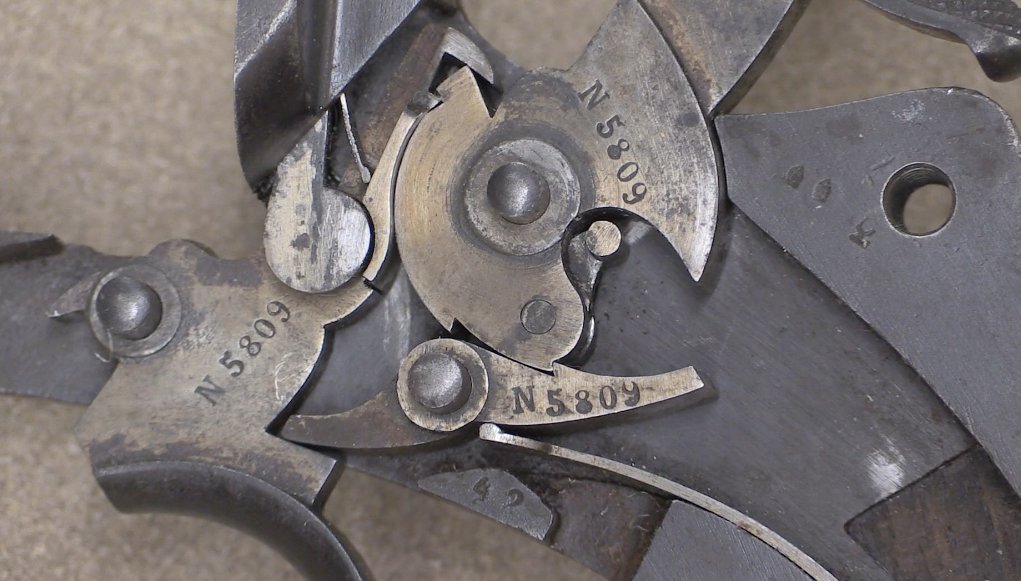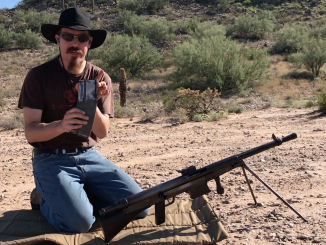The MAS-38 was France’s first officially adopted submachine gun, rushed into service in 1940. It was basically too late to help with the defense of France, with less than a thousand delivered by June 1940. The Germans kept the gun in production, making 20-30 thousand under the designation MP722(f). French production picked up immediately after the war, and 203,000 were made by the end of 1951. The gun would see service mostly in Indochina.
Mechanically, the MAS 38 is a simple blowback SMG, although it has a few unusual features. One is the approximately 6 degree angle between the barrel and receiver, which was done in order to drop the stock and allow a sight picture with shorter iron sights. As a result, the bolt face is also cut at about a 6 degree angle off perpendicular. The safety is the trigger itself, which folds up and forward to engage, locking the bolt in place. The weapon is chambered for the 7.65 French Long cartridge, which was also used in the 1935A and 1935S pistols. It is lighter than most other military submachine gun rounds, roughly on par with 9x18mm Makarov. That reduced ballistic peer does make for a very comfortable and controllable weapon, however.




” rushed into service in 1940″
I wouldn’t say so, it is developed for several years – according to
http://www.militaryfactory.com/smallarms/detail.asp?smallarms_id=481 existed early version called MAS 35
http://modernfirearms.net/smg/fr/mas-193-e.html states that early version is called SE-MAS 1935.
My understanding is that one early MAS 1935 prototype had a skeleton metal stock, while another had a wood stock, and two triggers á la Chatellerault FM 24-29 7.5x54mm LMG.
“That reduced ballistic peer does make for a very comfortable and controllable weapon, however.”
And its smaller diameter allow relatively short magazine holding 32 rounds.
I would like to see one of the companies making rimfire replica guns turn out a version of these.
Does anyone during WWII rework this gun to fire .32 Auto? This might be useful for Germans, as they already used .32 Auto.
If you can handle non-English black and white movies, there are several shots of this weapon in action in the 1966 documentary-style (honestly, I was surprised to learn that the battle scenes were staged, not archival front-line photojournalism) movie “The Battle of Algiers.” Great film, even if you don’t speak Arabic.
Gilo Pontecorvo’s _Battle of Algiers_ is one of the greatest movies ever made. Of course, he has Saadi Yacef of the FLN/ALN terrorist cells playing himself. Mostly all MAT49s, M1 carbines, and a few MAS 36 in the hands of conscripts, however.
Ennio Morricone did the sound track. If you ever see the footage of him describing what it was like working with Pontecorvo–demanding, perfectionist, eventually condemned to making TV commercials in his native Italy–it is hilarious. The score is very, very memorable.
Unfortunately, the film took on a complicated “life of its own…”It was first shown in Argentina, for example, to young cadets about the prospect of waging war against subversion… Well before the rise of Peronist and left-wing terrorism. All of the “guerre revolutionnaire” theorists went to Argentina, or had Argentine pupils in France, to impart the “lessons” of Algiers. This is the so-called “French Connection” of state terror to places like the Argentine “process of national reorganization” aka. the Guerra Sucia/Dirty War.
Pontecorvo’s epic _Burn!_ or Queimada is absolutely stunning too! Albeit muskets in that one…
The 32 French long shell was issued 2 ways as a brass cartridge case and copper clad bullet being rarer than the steel cased one with a TURNED STEEL bullet. This load is much more potent than you would think. While it never expands at all it does give very good penetration. Shooting 32 French Long out of a M35S into wet Sears catalogs it went twice as deep than 45 ACP ball and deeper than Nazi produced 9 mm ball. The French long and the 9 mm ball also penetrated a 70s era Chevy bumper that stopped the 45 Ball. Shooting cement blocks produced sparks with almost every hit. There is an interesting French movie ” the old gun” that depicts a man with a double barreled shotgun taking revenge on a group of MIlice armed with Mas 38 s who killed his wife.
Hi,
Not militia, but german troops.
http://i.f1g.fr/media/ext/805x453_crop/api-tvmag.lefigaro.fr/img/000/023/2320883.jpg
Apparently, the Germans issued the MAS 38 (which, of course, they had a special code [f] französisch fo) to personnel in the General Gouverment area of occupied Poland. One can find actual footage and photos of it in use there.
Also, if one consult’s Canadian scholar Biddiscombe’s book on the Werwolf Nazi underground, there are photos of MAS 38s in seized caches of weapons and explosives.
“The weapon is chambered for the 7.65 French Long cartridge”
Data from Альбом конструкций патронов стрелкового оружия.
NAME: 7,65-mm cartridge for sub-machine guns
MASS OF CARTRIDGE: 8,6 g
VELOCITY: v10 ~ 380 m/s
POWDER CHARGE: 0,32 g
DENSITY OF CHARGE: 0,58 g/cm3
POWDER TYPE: nitroglycerin, plate
AREA OF BARREL BORE CROSS SECTION INCLUDING GROOVES: 0,48 cm2
BULLET MASS: 5,5
POINT-OF-CENTER-OF-GRAVITY OF BULLET: 42,3 [or ,8 – scan unclear] % of length from bullet base
MASS OF CASE: 2,6 g
CASE CAPACITY (FULL): 1,21 cm3
CASE CAPACITY (BULLET SEATED): 0,53 cm3
PRIMER MASS: 0,15 g
MATERIALS:
-BULLET JACKET: steel, hardness 190 (Vickers)
-BULLET CORE: plumbum with addition of stibium
-CASE: steel
Muzzle energy of the 7.65 Long with the standard load is about 280 FPE, putting it right between the .38 Special and the 9 x 19mm power-wise.
Loaded with a more conventional FMJ/lead core bullet instead of a monolithic steel one, its penetration also fell between .38 Spl. and 9mmP. This probably made it more suitable for police use in places like Paris, which even in the fifties were seriously Built-Up Areas by modern standards.
The stock containing the recoil spring assembly predates that of the Johnson LMG, and may have been the first such setup seen on a production weapon. The stock shape of the original AR-15 has obvious affinities with the stock of the MAS 38.
I suppose as asked above that you could modify the MAS 38 to 7.65 x 17SR, by bushing the chamber, modifying the breechface and extractor for the semi-rim, blocking the magazine for the shorter round, and probably weakening the recoil spring, but why would you want to? You have a round that hits harder than a .38, almost as hard as a 9mm, and is by all accounts pretty accurate. I’d say it’s nearly ideal for at least in-town police work “as-is”.
cheers
eon
“why”
To have less cartridge in supply chain.
Daweo, my friend, you’ve opened up a can of worms there– German logistics in WWII were anything but “logical” even under Albert Speer! Recall that Hitler thought Germany could take each enemy state in turn and avoid a long war… No wonder industry, the armed forces, all of the bureaucratic in-fighting, etc. made for such a chaotic situation. By the end of the war, the Nazi party militia–“Volkssturm” was primarily armed with Italian weapons because the Germans had been able to more systematically loot the arsenals and store houses there under their occupation. But lots of weapons from elsewhere without cartridges, or the wrong kind went out to each of the Gauleiters trying to cobble together a retinue of armed followers among the old, young, infirm in their respective “Gau.”
Of course. Germany was maneuvered into war by those pulling strings in Britain and the U.S. The only one who denies this is Ross N. Ferrite.
John Pedersen’s Pistol, caliber .30 Model 1918 or “Pedersen Device” cartridge appears to have convinced the French, at least, that it was a good cartridge.
“John Pedersen’s Pistol, caliber .30 Model 1918 or “Pedersen Device” cartridge appears to have convinced the French, at least, that it was a good cartridge.”
http://www.municion.org/7_65x20/7_65x20.htm states it even was based on .30 Pedersen Long.
It seems MAS-38 SMG was used to kill Benito Mussolini in a small town close Como Lake in 28th april 1945.
I think you are likely wrong, as the Italians preferred the Beretta MAB-38 series. Why would the Italian partisans use French guns!?
Cause partisans used everything that was available.
Yes, but I doubt the Italians would import French guns in the first place! There would be way too much trouble in supplying ammunition, since 7.65 Long is clearly NOT made in Italian munition factories!
Here is an article with the claim:
http://www.guns.com/2011/08/17/the-mas-38-765-mm-submachinegun-dishes-out-poetic-justice-in-french-and-italian/
Yes. Musolini was killed with the MAS 38. Recall that Italy hived off a border region of Southern France. Recall as well that deserters from that area, leavened by people who “got out of jail” during Italy’s switching of sides hiked over the mountain passes. It is a permeable border during an upending of authority.
The actual specimen itself is thought to have been gifted from the PCI Garibaldini to Albania under ol’ Enver Hoxha–the original OG prepper dictator! Not sure what museum it is supposed to be in…
“Why”
MAS 38 is noticeable smaller than MAB 38
I hand load 32 French Long for my Mdl 1935 pistol. It is a very nice round to shoot and very accurate with modern hollow points. Would love to get my hands on a MAS 38 SMG, but I cannot afford the government mandated artificial inflation put on NFA guns. Maybe some day………
Interestingly, I was always taught that the MAS 38 used the inclined plane as a part of the locking system, enabling a lighter bolt and more substantial resistance to the rearward travel of the bolt. This principle was also used in the Jatimatic submachinegun from Finland in the late 1980s, and the pair of them represent the sole uses of this mechanical effect in firearms that I’m aware of.
“sole uses”
See KRISS sub-machine gun
http://modernfirearms.net/smg/usa/kriss-super-v-e.html
where path of moving parts is not parallel to axis of barrel
See also Patent US 1457961 A Firearm:
https://www.google.com/patents/US1457961
Yeah, with big difference that here the bolt is travelling downwards (in jatimatic upwards), so by gravity it would possibly be faster, thus easier to “unlock”. Or maybe there is friction at play, but then you get a disadvantage in feeding motion.
One interesting point to note : a weapon designer behind the Kriss explained in an interview he left France for the US in order to finish his project in a more firearms-designer-friendly environment.